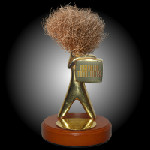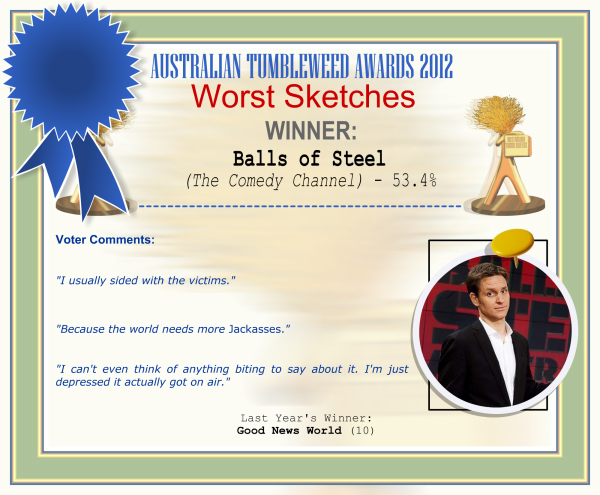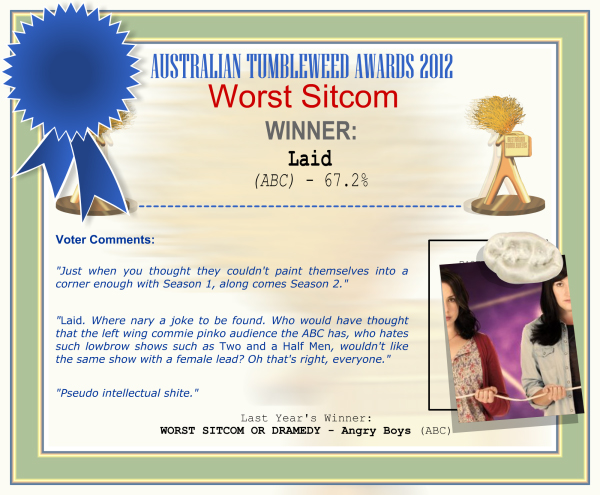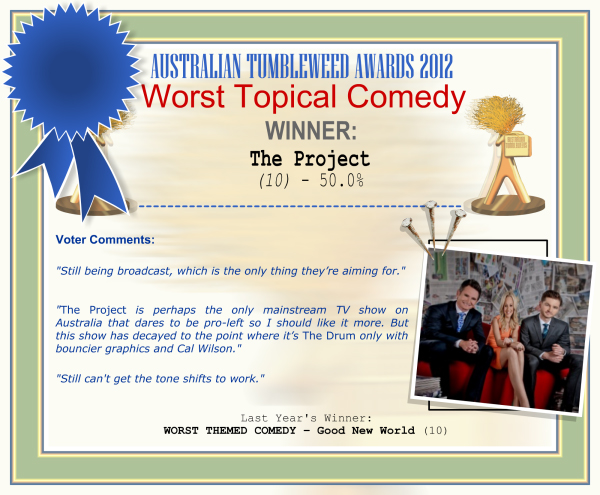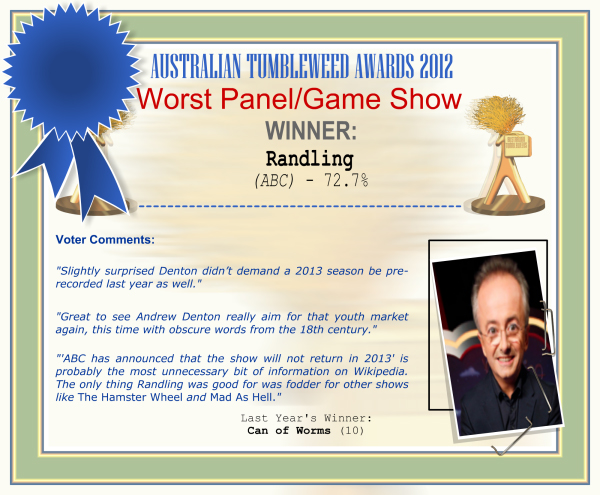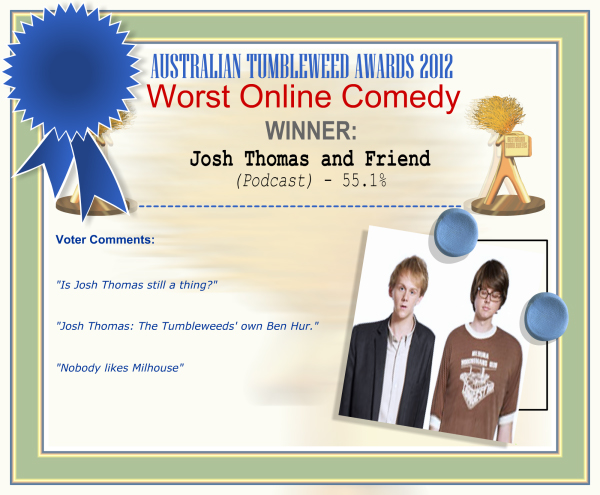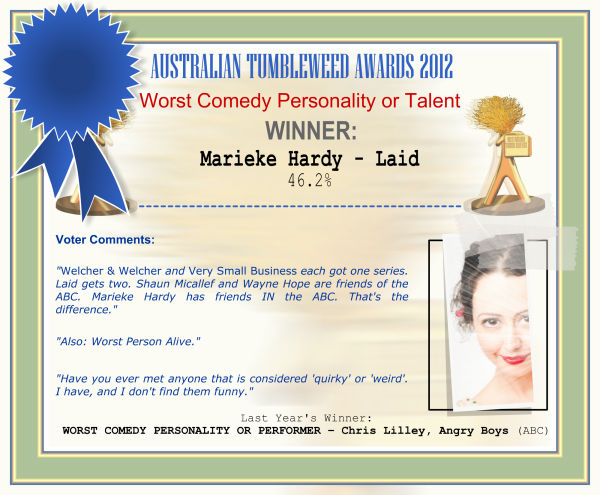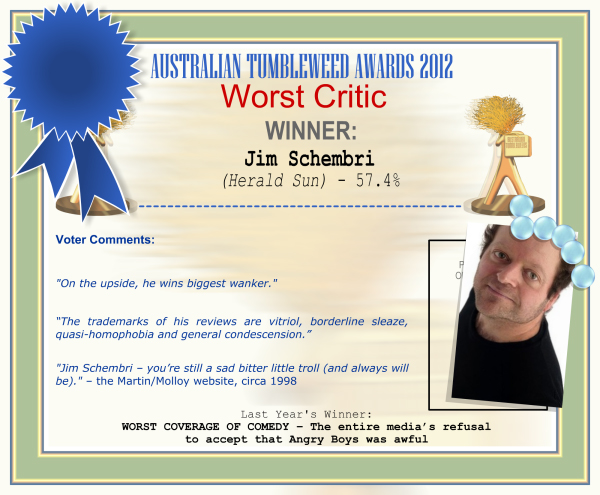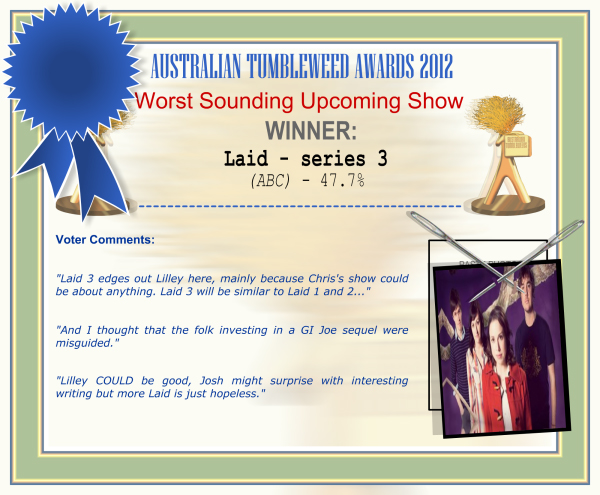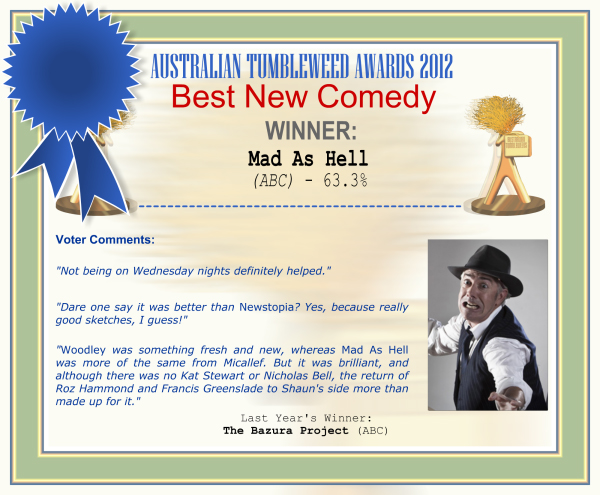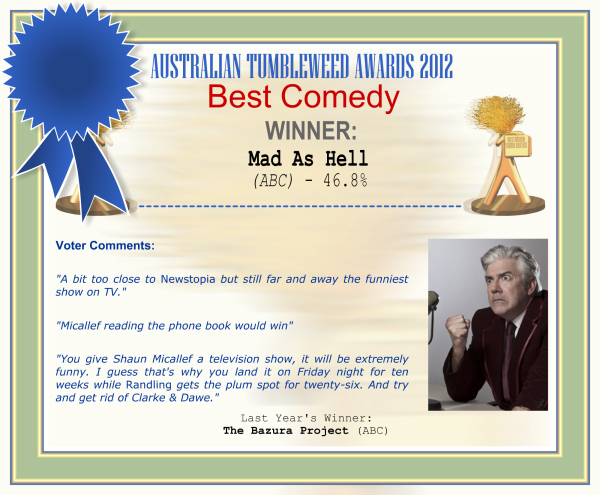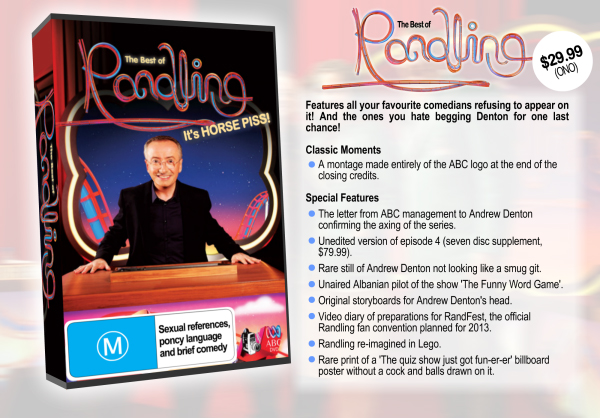Australian Tumbleweeds
State the Obvious and Win!
From the department of No Shit, Sherlock, comes this startling admission from ABC chief Mark Scott:
Scott told Mumbrella’s sister title Encore: “One of the things we did with Randling that we learned from, and this was partly a budget thing, was that we locked all that away. It was all locked away before it went to air. If we had been broadcasting it as we were making it, we probably would have fine tuned it along the way and we weren’t able to.”
That said, unless the “fine-tuning” involved ditching both the host and the concept, we kinda get the feeling things would have played out pretty much the same. But aww, isn’t it nice that the ABC boss is willing to divert attention from the show’s many other failings and shift the blame for it tanking onto something that never gets mentioned as a plus or a minus for any other ABC show? Seriously, when a show rates its arse off does the ABC ever say “it should, we sunk a bloody fortune into it”? Has there been any other dud that’s received the “don’t blame the show, we should have spent more money on it” get out of jail free card in recent memory? Jesus Christ, that hold Denton has over the ABC must be one hell of a headlock.
*
In further shocking news, today’s Melbourne Herald-Sun ran this in their “Confidential” section:
Matt Tilley and his popular “Gotcha” calls are no more, after the royal prank call scandal.
Wait, the royal prank call scandal killed Matt Tilley? YEEEEAAAAAA-oh wait, they just mean his prank calls are no more. Damn you, dead UK nurse, for depriving innocent fun-loving Victorians of Matt Tilley’s “popular” phone abuse. Let’s continue:
Fox FM will not broadcast the calls on its breakfast show this year, and probably never again. The dumping of the Gotcha pranks came after British nurse Jacintha Saldanha took her own life soon after taking a call from Sydney radio hosts Michael Christian and Mel Grieg … Tilley and Fox FM have been doing the calls for years, releasing a number of CDs that have performed well on the ARIA charts. Fox FM’s parent company Austereo announced in December that the company would suspend all prank calls. This ban now looks like being permanent.
And then, just when you think you’re reading a story that might as well be headlined “SYDNEY RADIO KILLERS MURDER MELBOURNE’S FUN”, there’s this:
Nothing has been heard from Grieg or Christian since they did interviews soon after the scandal broke in December. It seemed they were scapegoats in the affair, as little was heard from the content producers or directors who would have approved the prank call.
Which, by the Herald-Sun‘s standards, is actually almost insightful. Even if it is just calling for the real culprits to stick their heads up so they can have a kick at them.
Act your age!
While we were getting all worked-up about the likes of Balls of Steel Australia and The Janoskians for the 2012 Australian Tumbleweed Awards, The Comedy Channel started airing their latest “original” pranks show Off Their Rockers. Based on the American program Betty White’s Off Their Rockers, which in turn was based on the Belgian program Benidorm Bastards, Off Their Rockers sees a gang of senior citizens hitting the streets of Sydney, doing unexpected things in front of the public.
The ensuing hilarity is linked by sports commentator Sam Kekovich, who helpfully explains the premise (because presumably we’re too stupid to spot it ourselves): this show features a bunch of oldies behaving like teenagers. Cue 30 minutes of home video camera footage of elderly people snogging in the street, smoking reefers in the park, and asking for Cowboy Cocksuckers in pubs.
As a throwaway piece of summertime TV aimed at bored people this is just about acceptable. And unlike shows such as Balls of Steel Australia, at least the laughs come from the ludicrousness of the old timers’ behaviour and the bewildered reactions of the young people in their vicinity rather than the mean-spirited targeting of innocent passers-by: two elderly women walking past a building site yelling “Show us your tits!” at the builders makes the builders laugh – no one’s being harmed there.
What is irritating about Off The Rockers is the shooting style. The pranks themselves are quick and done reasonably well, but then the seniors walk out of shot and the camera closes in on the group of teens who happened to be sitting nearby. And then stays there for ages. The editor’s even slowed that part of the footage down to emphasise how bewildering/hilarious the teens found the oldies’ antics. And what with that and Kekovich’s pointless narration it feels like the makers of the show are trying to make a small amount of footage go a lot further than it should, which for a show which probably cost about $1.50 to make seems penny-pinching in the extreme.
Australian Tumbleweeds 2012 – voting is almost closed
Okay, so your chance to vote in this year’s Tumbleweeds Awards is almost over, and if you haven’t voted by now* there’s a good chance you never will. Which, let’s be blunt, would be a massive mistake on your part.
Let’s explain: some years it’s pretty clear that Australian comedy just stank up the place and these awards are just making it official. Other years there was enough good stuff around that avoiding the bad was surprisingly easy and we’re just making sure the stinkers don’t crawl away unnoticed. 2012 fell into neither category.
Instead, 2012 was a year full of crap that people are already talking up as some kind of new Golden Age. Don’t believe us? Check out the fine work of TV blogger and radio commentator Steve Molk:
Snuck under the radar: The return of Australian comedy to TV – particularly the ABC
(Notable mentions: Santo, Sam & Ed’s Sports Fever [Ch7/7mate]; Southland [Ch9]; Can Of Worms [Ch10]; Laid S02 [ABC1]; The Strange Calls [ABC2]; The Unbelievable Truth [Ch7]; Adam Hills In Gordon Street Tonight S02 [ABC1]; Mabo [ABC1]; Episodes [Ch9]; Good Game [ABC2].)
Problems. A Moody Christmas. The Warehouse Comedy Festival. Kane and Disabled. The Hamster Wheel. Shaun Micallef’s Mad As Hell. The Strange Calls. Woodley. Laid. Agony Uncles/Aunts. Outland. Danger 5. The Roast. Audrey’s Kitchen. Even Hamish & Andy’s Euro Gap Year. It’s building and we’re well overdue the return of good Australian comedy to our screens – the crop we received this year was plentiful and we want more. MORE, DAMMIT – MORE!!!
Far be it for us to point out that there was roughly the same amount of Australian comedy on our screens back in 2011** and that the overall improvement in quality was pretty much non-existent (basically, we lost Talkin’ ’bout Your Generation and gained Randling), even though that’s pretty much our job here. More importantly, who in their right mind wants more of Laid or Problems? Oh wait, this is the guy who’s website is “Challenging opinions of today’s TV” – presumably he meant to write something like “Challenging your opinions of today’s TV” – and yet his preview of Problems contained this example of Olympic-level fence-sitting:
“this sneak peek at Problems offers us an insight in the level of risk the ABC took in commissioning the series and just how well it’s going to pay off.”
Of course it “offers an insight”. So does literally everything else that had anything to do with the show, up to and including a photo of an empty set. If you’re going to be a critic and not just the network’s friend, you yourself have to offer up your own insights. It also helps if they’re not the same as every other fence-sitting critic (you didn’t like Randling? Uh yeah, that bandwagon left six months ago) and they don’t involve you tweeting at every television personality you can find trying to make friends with them.
The important thing is, whatever our issues with him Molks is one of the more high profile online television critics in Australia and he’s telling you that 2012 was a great year for Australian comedy. He’s not alone: how else to explain Fairfax claiming that the best Australian comedy program of 2012 was Agony Aunts / Uncles? We’ve ranted about this debacle before, but seriously: if that’s the highwater mark for the year, then the year was spent in the stinking remains of a drought-drained swamp.
So let’s be blunt: if you don’t vote in this year’s Tumbleweeds, you’re saying you have no problem with what these people are putting out there. They’ve already had their say about the state of Australian comedy in 2012, and the obvious sacrificial lamb aside – that would be Randling, a dud so massive even Australian television critics had to acknowledge it – they liked what they saw. First class stuff all round guys, pat yourselves on the back for a job well done. “The crop we received this year was plentiful”. Certainly sounds like a big thumbs up to us.
We, as usual, would beg to differ. We certainly hope you do too.
*Your online voting form can be found here: https://www.surveymonkey.com/s/tumblies2012votes
**That Fairfax “best and worst of 2012” TV list actually complained about the lack of Australian comedy on our screens in 2012. C’mon guys, you can’t both be right!
Australian Tumbleweeds 2012 – voting now open
Voting is open in this year’s Australian Tumbleweeds 2012. Now in its 7th year, the Australian Tumbleweeds hails the failures (and occasional successes) of this nation’s comic talent.
Your online voting form can be found here: https://www.surveymonkey.com/s/tumblies2012votes
You have until midnight on Sunday 6th January 2013 to vote. Please only vote once. Full rules and instructions can be found with the voting form.
The winners will be announced on or about Australia Day.
As always, the official Twitter hashtag is #tumblies.
Death in voices
While you’re thinking about your nominations for this year’s Australian Tumbleweeds Awards, we want to draw your attention to this blog about the “Royal Prank” and the consequent suicide of Jacinta Saldanha. It highlights some of the issues we’ve been thinking about over the past couple of days, including the culture at Austereo radio stations that seems to be as much, if not more, to blame for Saldanha’s tragic death. You can lay blame the DJs, or the producers, or management, or the hospital’s patient privacy policy, but the real problem is the source – and unfortunately it’s the hardest to fix.
Britain’s Leveson Inquiry into the culture, practices and ethics of the British press, sparked by the News International phone hacking scandal, shows us that while it’s not exactly a waste of time investigating the problems with the culture of an industry or organisation, there’s also not much you can really do to change it. A week or so after Leveson’s report was published Britain’s tabloid reporters were harassing Saldanha and her colleagues about the Royal Prank. Why? Because it’s how they get the stories to attract the readers to buy the newspapers they write for.
Similarly, in Australian commercial radio the job of the DJs is to come up with content that will keep the audience listening and phone pranks involving famous people are very much that. Sure, they get lawyers to look over anything that might be controversial, but in most cases it’ll be fine. If the Royal Prank hadn’t resulted in a suicide it’d be largely forgotten by now, even if the Police and ACMA had still decided to take an interest in it.
Audiences are pretty annoyed, of course, although probably not the regular listeners to 2Day FM to whom the station’s content is rigorously targeted. Sponsors may be withdrawing due to public pressure online, but once the fuss settles down they’ll probably come quietly back and everything will be back to normal. The problem, as the above-mentioned blog from The Preston Institute says, is the Austereo culture, and it’s unlikely to change: “I think they’ll just continue to live out their Mad Men fantasies, down another drink and continue to manage the PR.”
More likely to do some damage to Austereo are the hacking group Anonymous, who Mumbrella reports have made threats against the company. But any actions the group take are unlikely to result in the ongoing cultural change needed at the organisation. That would require an unlikely-to-occur mix of swiftly falling ratings, decreased sponsorship revenue, a courageous management team and attitudinal change amongst the station’s key demographics, and Anonymous’ incredible hacking skills can’t deliver that.
Well, It’s A Good Thing We’ve Never Liked Prank Calls Then
Earlier this week we were discussing whether to bother with a post on the prank call 2DayFM radio presenters Mel Greig and Michael Christian made to the hospital where the Duchess of Cambridge, AKA Kate Middleton, was being treated for morning sickness. We decided against it because prank calls are crap, 2Day FM is the sluice tray at the bottom of the commercial radio slops bucket and what little Australian media interest the call attracted had basically fizzled out by the end of the day anyway.
With the death – a reported suicide – of the nurse who was the initial victim of their prank, the situation has changed a little. For one thing, this article on Fairfax’s website now seems a little dubious:
AS PRANKS go, it has caused offence right to the very top. The Queen, Prince Charles, Prince William, sections of the British public, the British press, royalists across the world and even a bewildered corgi or two.
But, in Australia, those who are well practised in this art of japery said on Thursday that the British outrage over the phone call made by the 2DayFM radio presenters Mel Greig and Michael Christian to the private hospital where the Duchess of Cambridge, Kate Middleton, was being treated for morning sickness, is what makes it so good
Actually, let’s quote a bit more in case it gets taken down:
Asked about the royal stunt, Julian Morrow, from The Chaser, said on Thursday: ”It’s funny and I think Austereo was fairly silly to apologise.
”Prank calls are really legitimate and there’s plenty of really good ones. There’s a particular skill you apply in each case … they got through, it worked, that’s fine.”
Even radio presenters from rival stations were praising the duo’s stunt during the week. Michael ”Wippa” Wipfli, from the Fitzy and Wippa show on NovaFM (owned by DMG Australia), said Greig and Christian deserved credit for the fuss their prank has caused.
”Three cheers to them, I think they’ve done an amazing job … the joke went really well, they should have aired it,” he said on Thursday. ”Anyone that doesn’t laugh at this story, and works in the media, is just angry they didn’t do it themselves. They’ve done well, I take my hat off to them.”
Wippa, who performs regular radio pranks with his co-star Fitzy (including impersonating Hugh Jackman and Russell Crowe in calls to the Chateau Marmont) said the 2DayFM call would have initially been about amusing listeners with funny voices and corgi sounds but the comedic approach would have changed dramatically when the nurse went along with it.
”It’s one of those things where the joke paid off,” Wippa said. ”The prank was there, they conned the person. They managed to convince a person that it was actually the Queen. The gag is they would be in disbelief that they actually managed to convince someone.”
Despite the official public apology from Austereo, Greig and Christian were said to be privately delighted by the global reaction. Their names (and the 2DayFM brand) have made headlines across the world, particularly in Britain, where the world’s most notorious tabloids have declared their outrage.
Yeah, in hindsight that probably doesn’t look good.
The question that will no doubt be asked in the coming days and weeks is, are pranks legitimate comedy if this is the result? Not that that’ll be the right question to ask: at this early stage we have no idea how cause and effect has worked in this case. Was she being hounded by the British Tabloids? Was she under pressure at her job? What was her prior mental state? What was going on in her personal life? At the moment we – and by “we” we mean “the kind of media commentators who rush to pass judgment on this kind of story” – have no real idea past various unsubstantiated news reports. We may never know: for one thing, it’s hardly likely her employers – or her co-workers, or the royal family, or anyone else – will now openly admit they put pressure on her in the wake of her falling for this prank.
Usually at this stage we’d pause to consider what effect this tragedy will have on the world of comedy. There are always forces – shadowy, sinister, no-fun forces – looking for a way to whip up outrage against comedians as a way to exert their own moral authority. But despite the cement-mixer loud volume of the initial hand-wringing, in this case it’s already perfectly clear what effect it will have on comedy (or more realistically, “comedy”, what with of-course-it’s-not-bullying pranks being pretty dubious laugh-getters in our book): bugger all.
2Day FM has been playing shit pranks on their listeners – insert joke about Kyle Sandilands’ entire career here – for years now, and nothing thrown at them so far seems to have dented their desire to give the bottom of the barrel a right seeing to. Remember all the outrage when they interviewed and named a 14 year old rape victim live to air? Remember how that changed everyt… oh right, nothing at all changed. They’ll make the appropriate noises, throw the presenters under a bus (while presumably the producers only get a rap on the knuckles and management not even that), dial it down a little over the non-ratings period and come back next year like nothing ever happened. Like nobody even died.
We don’t cover “comedy” on commercial radio here much any more, mostly because commercial radio comedy has – is there a stronger word than “devolved”? – into a slurry of giveaways, shouting and naked abuse. Which, if the ratings are any guide, some people seem to enjoy. Whether the end result is particularly healthy for those involved – this is hardly the first suicide linked to the Austereo network, after all – clearly those cranking the handle at this particular sausage factory aren’t all that concerned.
Vale All And Sundry Chaser Projects
In some circles it’s become increasingly fashionable to suggest that The Chaser’s best years are behind them. Yes, we have boring friends. Also: say what now? When exactly was this golden age of The Chaser meant to have taken place exactly? Those two years when The Chaser’s War on Everything threw increasingly desperate and pointless pranks on screen week after week as it staggered towards a finish line that must have seemed a thousand years away? The controversy-marred third season, which succeeded only in whipping the tabloid press into a frenzy over a sketch that felt half-baked at best? The first season of The Hamster Wheel, which in hindsight was a show unsure of itself and best described as “mildly uneven”? Or those election specials where they snuggled up to various politicians and gave the vile turds who seek to run every aspect of our lives the opportunity to pretend they’re in on the joke? Run for the shadows, run for the shadows, run for the shadows in these golden years.
So let’s just say we reckon The Chaser of 2012 is at least as good as it’s ever been. While The Unbelievable Truth was yet another comedy panel show, it was at least a comedy panel show that didn’t stink up the joint. Seven showing back-to-back episodes was too much of a moderately good thing and we’re not going to pretend it didn’t have its fair share of dud segments (hey look it’s Scott Dooley) but unlike just about every other Australian comedy panel show in recent memory, laughs were had.
It was great to see The Umbilical Brothers on non-children’s television, Kitty Flanagan is always good value, the Chaser members who appeared as guests held their own, Sam Simmons’ style of comedy actually worked for us for once, and overall – due perhaps to coming out of Sydney, and thus being unable to fall back on the increasingly worn-out Melbourne comedy regulars – the show felt a little fresher than we expected going in to what was, after all, yet another comedy panel show.
Part of the credit has to go to host Craig Reucassel, surprisingly enough*. It’s taken The Chaser team a very long time indeed to actually get comfortable in front of the camera – and by comfortable we mean “comfortable enough to relax and have fun rather than just say the words and move on” – but here he actually seemed like a host willing to chip in and try and few jokes of his own to move things along. Sure, the whole thing could have been tightly scripted, but it looked a lot more relaxed than the usual Chaser deal, and that’s what we picked up on.
Over at The Hamster Wheel, our long held dream of a series that was nothing but the “What Have We Learnt From Current Affairs” segments from The Chaser’s War on Everything has finally come true. Frankly, the fewer traditional sketches they do the happier we are – for whatever reason, their sketches and fake news bits rarely fire, though they had a few winners – and this year they largely integrated that side of things into longer segments tackling one or another area of Australia’s rubbish media. And it worked! Largely because Australia’s media really is rubbish and making fun of them is both completely justified and a well that never runs dry, but generally they had good points to make and they made them well. Oh yeah, and it was funny sometimes too.
[something else that worked was their increasing use of bit players – we’re guessing they were their research team, as we recognised Lee Zachariah from The Bazura Project on camera every episode and he was listed in the credits as a researcher. Having non-core Chaser people turning up in the short one-joke cutaways that they increasingly peppered their segments with opened up the show and provided some much needed front-of-camera variety. And one of them was a woman!]
The other biggish change was they picked up the pace. A lot. How do we put this tactfully? For a variety of reasons (they’re not professional actors, for one) The Chaser are a team that works best when they’re putting a lot of material out there, not when they try to draw comedy out of a few jokes. Appearing in a year when Shaun Micallef – who can (together with his team) get 90 seconds of solid comedy out of one idea – this was more important than ever, and The Chaser really stepped up and fired those jokes out there at a rapid rate.
In previous years we’ve had our usual whinge about The Chaser doing the same thing over and over and over without ever stretching themselves or surprising us. After this year, if they wanted to do a ten week series of The Hamster Wheel (2012 version) for the next decade or so we’d be happy with that. They finally seem to have figured out what it is that they do best, and they’ve decided to do the best job of it that they can. We’re still waiting on that sitcom from them, mind you…
*As The Chaser’s frontmen, Chris Taylor and Craig Reucassel haven’t always brought the energy with them. Where Andrew Hansen has displayed flashes of dry wit, Chaz has felt like a tightly wound comedy machine and Julian Morrow has been “the brains” of the organisation, Chris and Craig have seemed a little too much like the guys who are there simply because it’s a solid gig. Maybe that decade of hosting has finally rubbed off, but Reucassel on The Unbelievable Truth and the duo (together with Morrow) on The Hamster Wheel finally came across as guys actually having fun in their jobs. Considering The Chaser has never really traded on its members personalities – they’ve always just been “themselves” in front of the character rather than playing larger-than-life comedy characters, so they’ve had nothing to hide behind – this newfound ease is a big leap forward.
[Agree that The Chaser had a good year? Think we’ve lost the plot and the “Chaser Lads” should be put out to pasture? The nominations for the 2012 Australian Tumbleweeds Awards are now open – our online nominations form can be found here: https://www.surveymonkey.com/s/tumblies2012noms]
Australian Tumbleweeds Awards 2012 – Nominations now open
Nominations are now open in the Australian Tumbleweeds Awards 2012. Now in its 7th year, the Australian Tumbleweeds hails the failures (and occasional successes) of this nation’s comic talent.
Your online nominations form can be found here: https://www.surveymonkey.com/s/tumblies2012noms
This year we have decided to reduce the number of public-voted awards, and to introduce a new Special Awards category for exceptional under-achievement in the field of Australian comedy. You may suggest Special Awards or Special Award recipients as part of the nominations process. The Special Awards are in the gift of the judges and their decisions are final.
You have until midnight on Friday 14th December to nominate. Please make no more than 4 nominations in each category. Full rules and instructions can be found with the nominations form.
Voting will start on Sunday 16th December and close on Sunday 6th January 2013, with the winners announced on Australia Day.
As always, the official Twitter hashtag is #tumblies.
Two Times The Love!
While we’d like to thank everyone who sent in cards and letters over the last few hours congratulating us on taking over the role of Head of Comedy at the ABC, bad news: we didn’t get the gig. It’s an easy mistake to make though, considering this was one of the main planks of today’s announcement of the ABC’s line-up for 2013:
we welcome the return of Australia’s favourite music quiz show SPICKS AND SPECKS – but it will be no cover version
Remember when we said this back in March?
1): Bring back Spicks & Specks. Okay, the horse has pretty much bolted here. So why the hell didn’t they keep the show going and just change the host? It was extremely obvious from the second In Gordon Street wasn’t a massive car crash that Hills was going to bail on S&S. Fair enough too, he’d clearly had enough. But let’s be honest: unless you are a relative or close personal friend of Hills, he’s not exactly irreplaceable. He’s a moderately handsome host who can come out with ABC-level quips. Two words: Will Fucking Anderson. Or pretty much anyone else, including your local postie. Yes, he was good at his job. His job was hosting a musical quiz show. IT’S NOT THAT HARD. Just look at the UK, where they have loads of this kind of long-running show and think nothing of swapping out hosts when need be.
We’re not saying an idiot could do a better job of running comedy at the ABC at the moment. We’re saying that we’re idiots and even we could see the ABC had fucked up big time by kicking Spicks and Specks to the curb when they did. So we guess we might possibly be saying that idiots could maybe do a better job than the current crew. Ouch.
Then there’s this, which is a direct quote from the fancy big book proper TV journalists were sent today outlining the future of the national broadcaster:
“…drum roll… Chris Lilley is back… but if we told you any more, we’d have to kill you”
You don’t have to be a moron to recognise that line as the stock-standard “we don’t know either” cover-up. You also don’t have to be a moron to know that Chris Lilley has not made a show and brought it to air in under a year since 2005. So we’re going to call it: whatever Chris Lilley is working on will not be seen on Australian televisions in 2013. But thanks for keeping us posted.
Otherwise the comedy line-up is pretty much what you’d expect: all the high profile stuff looks crap, all the decent stuff has a blanket thrown over it. In the former pile we have The Agony Guide to Life – yes, Agony Uncles / Aunts is getting another go, which shows you just how disastrous this year was for the ABC – Joe Hildebrand is back with… something, they don’t even have a name for it because presumably RACE-BAITING was taken… the pointless “comedy” gameshow Tractor Monkeys looks set to follow firmly in the footsteps of every single other ABC comedy gameshow not called Spicks and Specks, It’s a Date is Peter Helliar’s chance to do for romantic comedy on television what he did for it on the big screen with I Love You Too (did we ever mention how that films co-star Peter “Game of Thrones” Dinklage had Helliar take out all the dwarf-tossing jokes before he agreed to do it?) and everything else is reality programming we’ll probably end up covering because there’s fuck-all else on for months at a time.
Oh, in Chaser news, there’s this:
The Chaser’s Julian Morrow and Craig Reucassel will give consumer affairs an extreme makeover in THE CHECK OUT
But we also think there’s a pretty good chance The Hamster Wheel or something like it will return in the second half of the year – after all, they didn’t announce its return at the 2012 launch either.
On the positive side, Gristmill’s Upper Middle Bogan looks promising and we’re pretty happy there’s going to be a second season of Twentysomething. We’re also happy but also somewhat puzzled that there is no mention anywhere here of Josh Thomas’ long-promised sitcom Please Like Me, first announced at the ABC’s 2012 launch. Guess they’re keeping it under wraps for a surprise attack later in the year.
Shows that are coming back include Adam Hills’ talk show, at least two separate flavours of Gruen (Nation and Planet), Audrey’s Kitchen – which is a pleasant surprise, as it was one of the stronger efforts from Working Dog in recent years – and Shaun Micallef’s Mad as Hell. Which is as good a segue as any into the other big announcement in Australian television today…
*
A lot of people have asked us over the last year or two why we bother reporting on anything that appears in The Age‘s television supplement, The Green Guide. We do so because while in theory they’re part of a large and credible news outlet worthy of our attention and respect, in actuality they have no idea what the hell they’re doing. For example, this week they released their annual “Best and Worst of the Year in Television” issue and hooly dooly is it a five star shocker.
They didn’t have separate categories for drama and comedy* – their best show of the year is Homeland, which seems to suggest they have extremely short attention spans and / or realised they couldn’t not give the number one slot to a show airing on commercial television even though Australian commercial television in 2012 basically took out ads saying “we just don’t give a fuck about quality” – so oh ho ho ho what classic show do you think they reckon was the best Australian comedy in 2012? Coming in at number eight:
Agony Aunts / Uncles (ABC1). Superbly cast, terrifically edited local series that provided frank, funny answers from a diverse group of men and woman. Has made stars – and landed a heap of work – for it’s breakout participants.
Putting aside the fact that the Green Guide staff thought that in 2012 there were only seven shows better than Agony Uncles / Aunts on Australian television – which is not exactly a decision designed to engender trust in their mental facilities- every single point they make is provably wrong just by watching five minutes of the actual show. Here, we’ve made a list:
* “Superbly cast”… with a whole bunch of creator / host Adam’s Zwar’s comedy mates up to and including his own wife. If you weren’t passably attractive and under 40 you’d better be a big name or talk a lot of crazy sex stuff or you were nowhere to be seen.
*”Terrifically edited”… actually, the rapid-fire editing and constant cutting between talking heads did a really good job of making the whole show feel like a shallow bowl of plain mush. It was a collection of soundbites, not a narrative.
*”Diverse group of men and woman”… see “superbly cast”, only while you could argue about the quality of the cast (such things being subjective), calling the B-list comedians and Sunday paper talking heads here “diverse” is a bigger joke than any of the ones the guests cracked.
*”Has made stars – and landed a heap of work”… for Lawrence Mooney.
(not that their love of the show was really all that surprising – it was basically the same soft opinion / relationship material The Age runs all weekend every weekend)
After that, we pretty much gave up on the rest of the list (even if The Hamster Wheel came in at number nine because “Nobody comes close to doing what the Chaser lads do on Australian TV”… apart from Media Watch, the Gruen shows and Shaun Micallef’s Mad as Hell, of course), but we did keep on skimming just to see whether our current front runner for fave comedy of the year Mad as Hell placed, just so we knew where we stood with this list. Surprise! Turns out our position regarding this list wasn’t so much standing as sitting on the toilet looking for something to wipe our backsides with:
20. Why we’re torn about Shaun Micallef Is Mad As Hell (ABC1)
For: Federal politics has been certifiably bonkers this year – bleak, joyless farce. But for 10 weeks, at the apex of the carbon tax battle, Shaun Micallef’s wilfully perverse news satire provided a weekly dose of pleasurably silly mockery. There were always incidental pleasures in the characters’ names (especially Veronica Milsom as reporter Xanthe Kalamazoo), but highlights played on headlines: Francis Greenslade’s softly menacing union official; Tony Abbott’s ”national hairnet tour”; the dance choreographed to Craig Emerson’s ”Whyalla Wipeout”. I loved best the jokes at the expense of Fairfax and the future of print – especially the skit where the fish-and-chip shop wraps the flake in an iPad.
Against: The people spoke and the ABC listened, which is how Shaun Micallef was given a chance to flex his muscles as a writer, performer and avowed news junkie in this eponymous current-affairs satire. But anyone who saw his earlier go-around on SBS, the inventive, cheap and cheerful Newstopia, quickly realised that a polished production and overplayed gesturing didn’t value-add. There were some bright spots – enough, evidently, for a return season next year.
That was 20 in their Worst Shows of 2012 list. Seriously. And the worst thing they seem to be able to say about it is that it’s kind of like Newstopia, which they seem to have enjoyed. No-one tell them The Footy Show is the same old shit year in year out, their heads might explode.
Now, we know full well these lists are largely about shit-stirring – or “trolling”, as the people on Today Tonight like to call it. We know the point is to say controversial things to get people paying attention to you. And we have no problem with that when it’s done online, or when it’s a columnist speaking their mind. But when a supposedly reputable source of television coverage – a place people are meant to be able to go to for reviews of television shows that will give them a serious idea of what the writer thinks is worthwhile viewing – tries to pull off the kind of wacked-out shit that this list does (AGONY UNCLES / AUNTS WAS THE BEST AUSTRALIAN COMEDY SHOW OF 2012 EVERYONE!!), all we hear is the sounds of them flushing the shredded remains of their credibility down the toilet.
If the Green Guide wants to start basing its approach around saying controversial / bizarre / hilarious shit to get attention, it’s going to have to become a lot more entertaining. Because as it stands, it’s not smart or funny enough to stand as a decent read on its merits and it sure as shit can’t be taken seriously as a source of quality reviewing. Who would have guessed the days when Marieke “I made a completely superfluous second series of Laid and it didn’t make the worst shows of the year even though it rated worse than Randling” Hardy would give glowing reviews of shows on the ABC while actually working for the ABC would seem like a golden age?
*they did have a sidebar complaining about the overall lack of Australian comedy on television this year, seemingly unaware that it was actually one of the better years for Australian television comedy – in quantity if not quality. Guess what they meant to say was “Any year without a series by Chris Lilley doesn’t count”.
